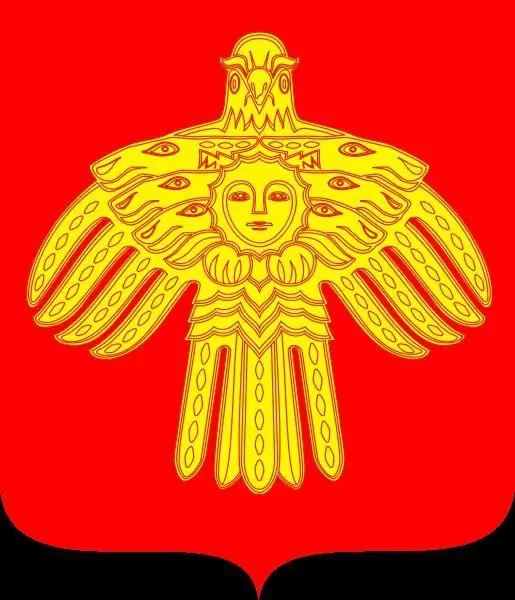- Author Harold Hamphrey [email protected].
- Public 2023-12-17 10:06.
- Last modified 2025-01-24 11:10.
The Izhma River flows through the territory of the Komi Republic. It is the left tributary of the Pechora.
Location of the river

The Izhma River is almost entirely located on the territory of one republic of the Russian Federation. Its overall length is quite impressive. It is 531 km. At the same time, the total area of the basin of this river is slightly more than 30 thousand m22.
The Izhma River in Komi takes its beginning on the south side of the Timan Ridge. From here it starts and heads northwest. In the upper reaches of the river significantly changes its appearance. Its banks are covered with massive forest plantations. In the lower reaches, the river flows through swamps and meadows.
Izhma's rapids

Its channel is very winding, which attracts many tourists. For example, lovers of kayaking. After all, in the middle and upper reaches there are often rapids and rocky rifts that are difficult to pass.
The largest of them on the Izhma River is located near the city of Sosnogorsk. Slightly downstream of the village. This threshold is called Selet-Kosyet, which literally means "Heart" in the language of local peoples.
This river is navigable for a long time. Ships and ships can sail frommouth of the Ukhta River. It is from here that navigation begins on the Izhma River in the Komi Republic.
In the lower reaches of the Izhma, it expands significantly. At the same time, it becomes difficult for the passage of ships. A large number of backwaters and channels appear. At the same time, the flow of the river is greatly weakened. And in addition, there are large islands that you constantly have to go around.
The Izhma flows into the Pechora near a small village called Ust-Izhma. The river has many tributaries. On the right side, the largest are Sebys and Ayuva. And on the left side, these rivers are called Ukhta, Sedyu and Kedva.
A remarkable place near the mouth of this river. Historians and archaeologists have discovered an ancient settlement, which is known as Poganiy Nos. On it, scientists found artifacts that date back to the 11th-13th centuries. Among them is an iron ax with a wide blade, spearheads and arrowheads, an armchair equipped with a bronze handle. Presumably, all these items belonged to Novgorod residents, who considered themselves to be state people. They were directly involved in collecting tribute.
Settlements in the Izhma region

From this article you learned where the Izhma River is located. It is worth noting that there are a large number of different settlements along its banks.
For example, in the upper reaches the river flows through a fairly large village called Verkhneizhemsky. It belongs to the municipal district of Sosnogorsk. There are about 10 streets in the village. According to the latest census, there are almost 900residents.
In the middle course of the river is the town of Sosnogorsk itself. At this point, the Ukhta River flows into Izhma. It is noteworthy that until 1957 this city was called Izhma. This settlement is located almost 350 km from the center of the region - Syktyvkar. About 26 thousand people live in it. Traces of primitive communities dating back to the Stone Age were discovered by scientists at the site of Sosnogorsk. The modern history of the city dates back to the period of Soviet industrialization in 1930-1940.
At 8 km up the river is the city of Ukhta. This is the second largest settlement in the Komi Republic. Its population is almost 100 thousand people. Ukhta received city status in 1943. After the end of the Great Patriotic War, processing and other industries actively developed here, building materials were produced. Main pipelines were built to supply oil and gas to other regions.
Today it is a large industrial city with a well-developed resource base. The economy is famous for its developed transport and industrial infrastructure.
There are many skilled workers here. Several design and research institutes operate in the city.
Akim village stands at the mouth of the Izhma. It originated in the middle of the 19th century. The name was given in honor of the founder, whose name was Yakim. Now the village is in decline. According to the latest census, only 21 people live in it.
Pechora Basin

According to the water register, Izhma belongs to the Dvino-Pecherskybasin district.
The water management sections of the river are divided as follows: this is the Pechora itself from the confluence of the Usa to the Ust-Tsilma, and then the Pechora below the confluence of the Usa River.
Izhma directly belongs to the Pechora river basin.
Object hydrology
Basically, the river is fed by melting snow. Usually the reservoir freezes by mid-November. Ice breaks up on the river in spring. This happens after the May holidays.
Maximum water flow is about 1,300 meters per second. Such indicators are formed in May. Minimum indicators in February-March. No more than 80 cubic meters per second. In April, it rises sharply to almost 250. This does not allow the river to overflow its banks and dry up. Thanks to this, its flora and fauna are preserved.






